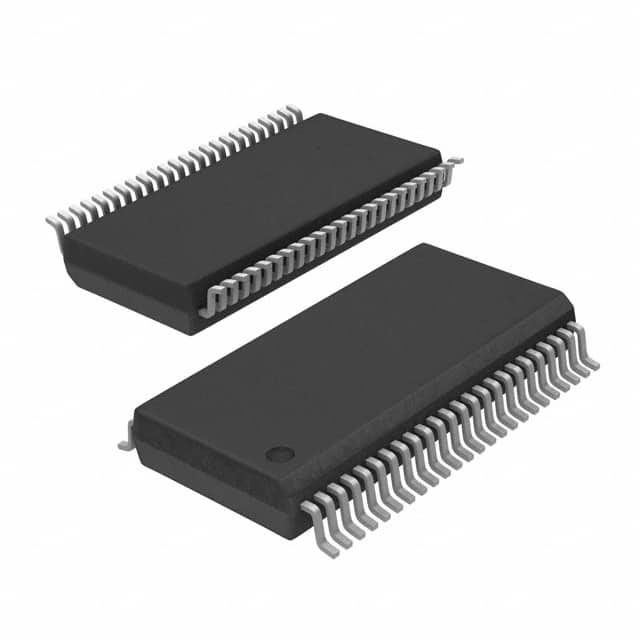Lihat spesifikasi untuk detail produk.

SN74LVTH16244ADL
Product Overview
- Category: Integrated Circuit (IC)
- Use: Logic Level Translator
- Characteristics:
- Low-voltage, high-speed CMOS technology
- Bidirectional voltage translation between different logic levels
- 16-bit wide bus interface
- Non-inverting outputs
- Package: TSSOP (Thin Shrink Small Outline Package)
- Essence: Logic level translation for interfacing between devices operating at different voltage levels
- Packaging/Quantity: Available in reels of 2500 units
Specifications
- Supply Voltage Range: 1.65V to 3.6V
- High-Level Input Voltage: 2.3V to VCC + 0.3V
- Low-Level Input Voltage: -0.3V to 0.8V
- High-Level Output Voltage: VCC - 0.4V
- Low-Level Output Voltage: 0.4V
- Maximum Propagation Delay Time: 5.7ns
- Maximum Operating Frequency: 200MHz
Detailed Pin Configuration
The SN74LVTH16244ADL has a total of 48 pins, arranged as follows:
- Pin 1: OE (Output Enable) 1
- Pin 2: A1 (Input/Output) 1
- Pin 3: Y1 (Output) 1
- Pin 4: GND (Ground)
- Pin 5: Y2 (Output) 2
- Pin 6: A2 (Input/Output) 2
- Pin 7: OE (Output Enable) 2
- ...
- Pin 48: VCC (Supply Voltage)
Functional Features
- Bidirectional voltage translation: Allows seamless communication between devices operating at different voltage levels.
- Non-inverting outputs: Ensures that the logic levels are preserved during translation.
- 16-bit wide bus interface: Supports the translation of a 16-bit data bus.
- Output Enable (OE) pins: Control the direction of data flow.
Advantages and Disadvantages
Advantages: - Wide supply voltage range allows compatibility with various systems. - High-speed operation enables efficient data transfer. - Non-inverting outputs preserve signal integrity. - Bidirectional translation simplifies interfacing between different voltage domains.
Disadvantages: - Limited to 16-bit bus width, may not be suitable for applications requiring larger data buses. - Propagation delay time may introduce timing issues in certain high-frequency applications.
Working Principles
The SN74LVTH16244ADL utilizes low-voltage, high-speed CMOS technology to perform bidirectional voltage translation. It consists of a set of input/output buffers and control circuitry. The direction of data flow is controlled by the Output Enable (OE) pins. When OE is low, the device is enabled, and data can flow bidirectionally. When OE is high, the device is disabled, and the outputs are in a high-impedance state.
The input buffers detect the logic levels of the signals from the lower voltage domain, while the output buffers drive the translated signals to the higher voltage domain. The non-inverting nature of the outputs ensures that the logic levels are preserved during translation.
Detailed Application Field Plans
The SN74LVTH16244ADL is commonly used in various applications where there is a need to interface between devices operating at different voltage levels. Some specific application areas include:
- Microcontroller Interfacing: Allows communication between microcontrollers operating at different voltage levels.
- Memory Interfaces: Facilitates data transfer between memory modules operating at different voltage domains.
- Communication Systems: Enables level translation in serial communication interfaces like UART, SPI, and I2C.
- Industrial Automation: Used in control systems to interface between different voltage level sensors and actuators.
Detailed and Complete Alternative Models
- SN74LVC4245A: Similar bidirectional voltage translator with an 8-bit bus interface.
- TXB0108: Octal bidirectional voltage-level translator with automatic direction sensing.
- PCA9306: Dual bidirectional I2C-bus and SMBus voltage-level translator.
These alternative models offer similar functionality but may have different specifications, package types, or pin configurations. It is important to select the appropriate model based on specific application requirements.
Word count: 524 words
Sebutkan 10 pertanyaan dan jawaban umum terkait penerapan SN74LVTH16244ADL dalam solusi teknis
Sure! Here are 10 common questions and answers related to the application of SN74LVTH16244ADL in technical solutions:
Q: What is SN74LVTH16244ADL? A: SN74LVTH16244ADL is a 16-bit buffer/driver with 3-state outputs, designed for low-voltage (3.3V) applications.
Q: What is the maximum operating frequency of SN74LVTH16244ADL? A: The maximum operating frequency of SN74LVTH16244ADL is typically around 200 MHz.
Q: Can SN74LVTH16244ADL be used for bidirectional data transfer? A: Yes, SN74LVTH16244ADL supports bidirectional data transfer, making it suitable for applications requiring both input and output functionality.
Q: What is the voltage supply range for SN74LVTH16244ADL? A: SN74LVTH16244ADL operates within a voltage supply range of 2.7V to 3.6V.
Q: How many output pins does SN74LVTH16244ADL have? A: SN74LVTH16244ADL has 16 output pins, corresponding to its 16-bit buffer/driver functionality.
Q: Is SN74LVTH16244ADL compatible with TTL logic levels? A: Yes, SN74LVTH16244ADL is compatible with both TTL and CMOS logic levels.
Q: Can SN74LVTH16244ADL drive capacitive loads? A: Yes, SN74LVTH16244ADL can drive capacitive loads up to 50 pF.
Q: Does SN74LVTH16244ADL have built-in protection features? A: Yes, SN74LVTH16244ADL has built-in ESD (electrostatic discharge) protection to safeguard against electrostatic damage.
Q: What is the power consumption of SN74LVTH16244ADL? A: The power consumption of SN74LVTH16244ADL depends on factors such as operating frequency and load conditions but is generally low.
Q: Can SN74LVTH16244ADL be used in high-speed data communication applications? A: Yes, SN74LVTH16244ADL can be used in high-speed data communication applications due to its fast switching speed and low propagation delay.
Please note that these answers are general and may vary depending on specific application requirements and datasheet specifications.

